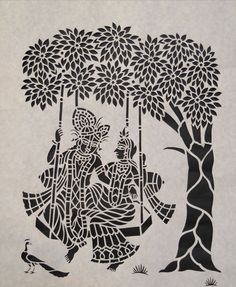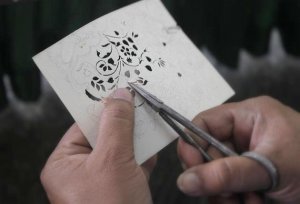Sanjhi Art
Sanjhi art is rooted in the folk culture of Uttar Pradesh (Mathura). We are all familiar with art but what does Sanjhi mean? The answer is ‘Sanjhi’ is a word derived from words like ‘sajja’, ‘srinagar’, and ‘sajavat’ which all means decoration. Sanjhi is the ancient art of paper stenciling paper across the whole of Mathur and Vrindavan.
To go back to its history, folklore tells us that the origin of this art form lies with Radhe, who made Sanjhi rangolis, using natural colors, along with flowers, leaves, colored stones to woo Krishna.
It was taken to its glory by the Vaishnava temples in the 15th and 16th centuries. It is related to the ritualistic practice of unveiling the rangolis in the temple with chanting at the dusk.

The creation of religious Sanjhi is not merely a recreational drawing but also an expression of love and devotion for the divine in general.
To create a Sanjhi design, stencils are made on paper using specially designed scissors and then use it to create an image. In the olden times, banana leaves were also used to create beautiful designs but nowadays, people use recycled paper.
Sanjhi art requires a lot of skill and patience because there needs to be a complete balanced composition without the aid of drawings. Firm control over tools used is very necessary to give concertized expression to the thought of the artist.
It makes use of peacocks, horses, bullock carts, trees, and butterflies as motifs. Stencil art is used for making decor and utilitarian objects like trays, mirrors, wall hangings, lampshades, and window partitions.
Each Sanjhi art is visually impressive, owing to the artist’s perfect portrayal of his thoughts. Sanjhi is also one of the greatest examples of the legacy of skilled Indian craftsmen which requires limited resources. Today the Sanjhi art is popular only in a few temples and is followed by only interested craftsmen, but we should not forget that it is still a part of our culture and heritage.



